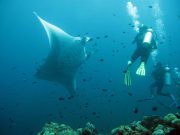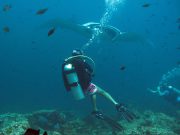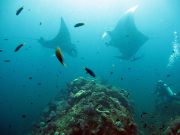Dykning med Mobular Strålar
Lanta Marina Liv | Mobulidae
Mobularrockorna, mantarockorna och djävulsfiskarna är en liten familj av rockor som mestadels består av stora arter som lever i det öppna havet snarare än på havsbotten.
Det finns 11 arter i denna familj, av vilka vi ibland kan se 1 viss medlem när vi dyker från Koh Lanta.
Mobularrockor, mantarockor och djävulsfiskar är stora pelagiska filtrerande rockor med en stor bred disk och 5 gälspringor på undersidan. De har stora bröstfenor och piskliknande stjärtar med en liten ryggfena. Bröstfenorna sträcker sig framåt och bildar ”horn” framför huvudet som kallas kefalfenor. Dessa fenor kan vikas ut för att ösa in föda i den breda munnen. Fenorna ser ut som djävulshorn och rockorna i den här familjen kallas ibland djävulsrockor.
Mobulidae består för närvarande av två släkten, Manta och Mobula. Släktet Manta omfattar två arter (Reef Manta & Giant Oceanic Manta) och det finns för närvarande nio erkända arter i släktet Mobula.
1 arter finns på denna sida:
Giant Oceanic Manta Ray
(Manta birostris)
Mantas are the largest of the Ray Family, reaching up to 8m from wing tip to wing tip! If we are lucky the Manta Birostris or Giant Manta, can be seen out on Hin Daeng and Hin Muang.
Rays along with Sharks are an Elasmobranch and have skeletons made up entirely of cartilage. The genus Manta is part of the Eagle Ray family, where it is grouped with Mobula Rays (Devil Rays) in the subfamily Mobulinae.

Manta birostris @ Hin Muang
There are two distinct species of Manta: the smaller Manta Alfredi, has a white or pale coloured mouth and tends to be resident in coastal areas. Manta Birostris, which is larger and has a much darker coloured mouth, these migrate across open oceans visiting reef mounts and pinnacles for cleaning, parasite removal and feeding.
Mantas have large pectoral fins, which give them a blanket-like appearance, hence their name Manta meaning "cloak" in Spanish. These large pectoral fins are able to propel them through the water, gracefully gliding and even making acrobatic movements.
Mantas are filter feeders and sieve their tiny food from the water. Most Rays have a mouth on the underside of their head, while the Manta have theirs at the front. While feeding, they use a pair of fleshy flaps on each side of its head called the Cephalic fin, to channel plankton into their mouths. These fins are rolled into spirals while not in use. Gill Rakers, finger like projections on the gill arches, strain and capture food. Like most Elasmobranch, they must keep swimming to allow oxygenated water to pass through their five pairs of gill slits.
Like Sharks, the Manta fertilises their eggs internally and gives birth to live young, called pups. The manta has one, sometimes two pups per pregnancy and are independent from birth. They will remain in shallow water for a about a year, before heading further offshore and beginning their migration cycle.
Dykning med Mobular Strålar runt Koh Lanta
Dykning och Snorkelutflykter
Om du vill ha en chans att se Mobular Strålar på en av våra dagliga högsäsongs dykresor från Koh Lanta, skicka oss ett e-postmeddelande till info@diveandrelax.com.
Följ med på våra dykresor med speedboat under högsäsong till några av Thailands bästa dykplatser och njut av små grupper, korta restider och fokus på personlig service, säkerhet och nöje.
Är du ännu inte certifierad dykare? Lär dig att dyka på Koh Lanta med den 3-dagars SSI Open Water Diver-kursen.
Boka online och spara 10 % på dykresor och dykkurser på Koh Lanta.
Ta Reda på Mer
Guider för Marina Djur och Växter i Indo-Stilla Havet
- Allen, G., Steene, R., Humann, P., DeLoach, N. (2003) Reef Fish Identification, Tropical Pacific. Jacksonville, FL., USA: New World Publications, Inc., ISBN 1-878348-36-1.
- Humann, P., DeLoach, N., (2010) Reef Creature Identification, Tropical Pacific. Jacksonville, FL., USA: New World Publications Inc., ISBN 978-1-878348-44-9
- Debelius, H. (2013) Indian Ocean Reef Guide. Frankfurt, Germany: IKAN - Unterwasserarchiv, ISBN 978-3-939767-52-7.
- Debelius, H. (2004) Nudibranchs and Sea Snails, Indo-Pacific Field Guide. Frankfurt, Germany: IKAN - Unterwasserarchiv, ISBN 3-925919-51-1
- Erhardt, H., Knop, D. (2015) Corals Indo-Pacific Field Guide. Frankfurt, Germany: IKAN - Unterwasserarchiv, ISBN 3-925919-69-4.
- Veron J.E.N., Stafford-Smith M.G., Turak E. and DeVantier L.M. (2016). Corals of the World


